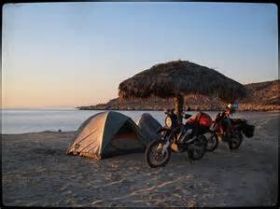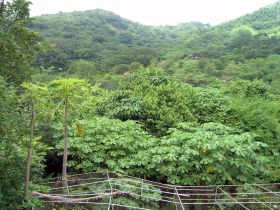Are there poisonous reptiles, snakes and insects, and dangerous animals in Mexico?
Sandi Vandiver
.jpg) There are poisonous reptiles, snakes, insects and other dangerous animals in some places in Mexico. The biggest threat to us here is dengue from the mosquitoes and the new mosquito-borne disease, which is quite similar to dengue.
There are poisonous reptiles, snakes, insects and other dangerous animals in some places in Mexico. The biggest threat to us here is dengue from the mosquitoes and the new mosquito-borne disease, which is quite similar to dengue. I’ve had dengue. It’s quite uncomfortable but I had a reasonably mild case. Now, there are many reports of people with dengue in Florida, South Texas, and similar places where it’s also sort of muggy and...
.jpg) There are poisonous reptiles, snakes, insects and other dangerous animals in some places in Mexico. The biggest threat to us here is dengue from the mosquitoes and the new mosquito-borne disease, which is quite similar to dengue.
There are poisonous reptiles, snakes, insects and other dangerous animals in some places in Mexico. The biggest threat to us here is dengue from the mosquitoes and the new mosquito-borne disease, which is quite similar to dengue. I’ve had dengue. It’s quite uncomfortable but I had a reasonably mild case. Now, there are many reports of people with dengue in Florida, South Texas, and similar places where it’s also sort of muggy and humid and they have lots of mosquitoes.
I don’t know about Mexico in general, but I can tell you that in some sections of Mazatlan, we have some fairly nasty scorpions. I don’t personally live in one of those areas. We don’t have snakes in town. There are sea snakes but I don’t go to the sea.
Mexico is a very geographically diverse country. In the forest, in the trees, in the mountains, there are jaguars, mountain lions, and those sorts of things. I’m not sure what they have out in the desert areas, but I would assume that in the Sonoran Desert there are probably rattlesnakes. I don’t have any personal involvement in that so the answer would be, we don’t have all that deadly stuff that they have in Australia, for instance, where they have the top five or six most deadly spiders and snakes in the world. But that doesn’t mean to say that the person couldn’t get bitten by a rattlesnake if they live out in the desert area or bitten by a jaguar or a mountain lion if they’re living up in the mountains. There are swamps north and south of here in Mazatlan. Just the south, and we have alligators, but there aren’t any here; they don’t come here in Mazatlan. In Mazatlan, you’d probably be more prone to be bitten by a dog.
Here in Mazatlan, in my day-to-day life, my concern over these dangers is very small. The mosquito would be the only thing I’m concerned about and on a day-to-day basis I never even think about that. We live in a hot and humid climate, but the worst roaches I ever experienced was in Austin, Texas. In some of the other places I’ve lived I have been plagued with my absolutely terrifying nemesis-- mice. But on a day-to-day basis I rarely think about it. I almost never see a spider.
(Jaguar, pictured.)
Posted September 30, 2015
Liliana Cota - Stewart Title Baja and Stewart Title Puerto Peñasco
 Mexico in general, and even the state of Baja, California, and the city of Tijuana have different topography. We have mountains, the beaches, and deserts. So depending on the nature of the surroundings, you could find different kinds of animals that, due to the wilderness, might be exposed to people, which usually happens when you go hiking or if you go to the desert. You could find snakes, and other animals in the wild. There are crocodiles in places like Yucatan or Chiapas but they are...
Mexico in general, and even the state of Baja, California, and the city of Tijuana have different topography. We have mountains, the beaches, and deserts. So depending on the nature of the surroundings, you could find different kinds of animals that, due to the wilderness, might be exposed to people, which usually happens when you go hiking or if you go to the desert. You could find snakes, and other animals in the wild. There are crocodiles in places like Yucatan or Chiapas but they are... Mexico in general, and even the state of Baja, California, and the city of Tijuana have different topography. We have mountains, the beaches, and deserts. So depending on the nature of the surroundings, you could find different kinds of animals that, due to the wilderness, might be exposed to people, which usually happens when you go hiking or if you go to the desert. You could find snakes, and other animals in the wild. There are crocodiles in places like Yucatan or Chiapas but they are in special places where they are not very accessible to humans.
Mexico in general, and even the state of Baja, California, and the city of Tijuana have different topography. We have mountains, the beaches, and deserts. So depending on the nature of the surroundings, you could find different kinds of animals that, due to the wilderness, might be exposed to people, which usually happens when you go hiking or if you go to the desert. You could find snakes, and other animals in the wild. There are crocodiles in places like Yucatan or Chiapas but they are in special places where they are not very accessible to humans.Generally, someone who is moving into Mexico and would be living in the average expat areas won’t have to worry about dangerous animals because dangerous animals do not go to areas frequented by humans. They are usually in the jungle or in the wilderness.
(Motorcycling camping at San Francisquito, Baja California, Mexico, pictured.)
Posted March 30, 2016
Yvon Marier - Travel Info Mexico
 In the city proper in Mazatlán, you won’t often see scorpions or snakes, because people are always spraying to keep them away. To see the snakes and scorpions, you have to go outside the city, where they don’t spray, like in the open field.
In the city proper in Mazatlán, you won’t often see scorpions or snakes, because people are always spraying to keep them away. To see the snakes and scorpions, you have to go outside the city, where they don’t spray, like in the open field. Mazatlán is right in the jungle, so you would expect there would be these types of animals. For example, right across the street from our home is a forest. I’m sure if I go into the forest,...
 In the city proper in Mazatlán, you won’t often see scorpions or snakes, because people are always spraying to keep them away. To see the snakes and scorpions, you have to go outside the city, where they don’t spray, like in the open field.
In the city proper in Mazatlán, you won’t often see scorpions or snakes, because people are always spraying to keep them away. To see the snakes and scorpions, you have to go outside the city, where they don’t spray, like in the open field. Mazatlán is right in the jungle, so you would expect there would be these types of animals. For example, right across the street from our home is a forest. I’m sure if I go into the forest, I might see some scorpions and snakes. Where people live, it’s very rare to see a snake. Not that it has never happened, but it’s very rare. I’ve been in Mazatlán for fifteen years, and I’ve only ever seen three scorpions. I’ve seen a snake two miles outside the city, in the forest, but it was not a venomous one- it was a nice snake.
I don’t really worry about seeing snakes, scorpions and other dangerous animals in Mazatlán. I’m more worried about the mosquitoes biting me than a scorpion or a snake. On the other hand, I don’t worry about Malaria, Yellow Fever and other diseases at all for me, my wife, our five kids and ten grandchildren. I know some people in Mexico who have had Dengue Fever, but it’s a rare occurrence.
(Mountain forest outside of Mazatlan, Mexico, pictured.)
Posted June 29, 2017



.png)